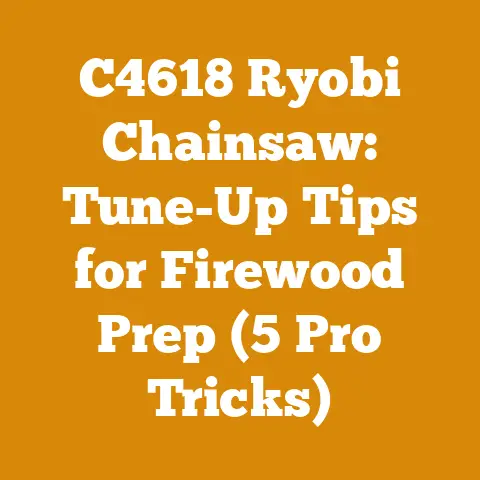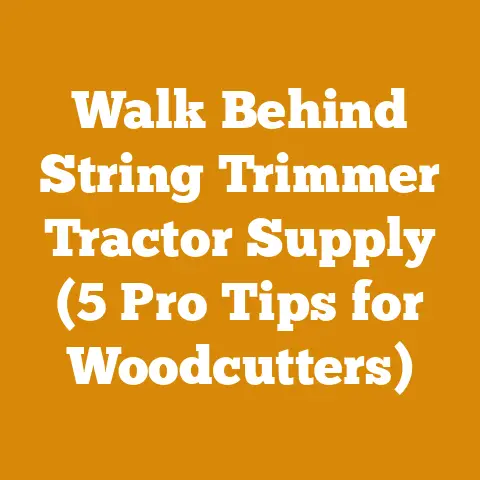Stihl 28 Inch Bar and Chain Guide (5 Essential Sizing Tips)
Durability isn’t just a buzzword when you’re talking about chainsaw bars and chains; it’s the backbone of efficiency, safety, and ultimately, your budget.
A worn-out chain or a damaged bar can drastically increase your workload, fuel consumption, and the risk of kickback.
That’s why understanding the nuances of bar and chain sizing, particularly for a workhorse like the Stihl 28-inch, is absolutely crucial.
Stihl 28-Inch Bar and Chain Guide: 5 Essential Sizing Tips for Optimal Performance and Cost Savings
Whether you’re a seasoned logger, a small-scale firewood supplier, or a homeowner tackling yard work, choosing the right bar and chain for your chainsaw is paramount.
In this guide, I’ll walk you through the critical aspects of selecting a 28-inch bar and chain for your Stihl chainsaw, focusing on how sizing impacts performance, safety, and your overall budget.
We’ll delve into the nitty-gritty of gauge, pitch, drive links, and more, providing actionable tips and data-driven insights to help you make informed decisions.
Understanding the Importance of Proper Sizing
Before we dive into the specifics, let’s understand why proper sizing matters.
A mismatched bar and chain can lead to several problems:
- Reduced Cutting Efficiency: The chainsaw won’t cut as quickly or cleanly, increasing your work time and fuel consumption.
- Increased Wear and Tear: The chainsaw components will be under undue stress, leading to premature wear and potentially costly repairs.
- Safety Hazards: An improperly sized chain can increase the risk of kickback, a dangerous situation that can cause serious injury.
- Poor Performance: The chainsaw may bog down or stall frequently, making it difficult to complete even simple tasks.
Think of it like wearing shoes that are too big or too small – uncomfortable, inefficient, and potentially hazardous.
The same principle applies to your chainsaw.
Tip #1: Identifying Your Stihl Chainsaw Model
The first, and arguably most crucial, step is to identify your specific Stihl chainsaw model.
Stihl, like any reputable manufacturer, offers a wide range of chainsaws designed for different applications, each with its own bar and chain specifications.
Why is this important?
Because not all Stihl chainsaws can handle a 28-inch bar.
Trying to force a 28-inch bar onto a chainsaw designed for a smaller bar length will likely damage the saw and void your warranty.
How to identify your model:
- Check the Owner’s Manual: The owner’s manual is your best friend.
It contains all the information you need about your chainsaw, including the recommended bar and chain sizes. - Look for the Model Number on the Saw: The model number is usually located on a sticker or plate on the chainsaw body, often near the engine.
Common locations include the side of the engine casing or near the handle. - Consult the Stihl Website: Once you have the model number, you can visit the Stihl website and enter it into the search bar.
The website will provide detailed information about your chainsaw, including the recommended bar and chain sizes. - Talk to a Stihl Dealer: If you’re unsure about your chainsaw model or the correct bar and chain size, visit your local Stihl dealer.
They can help you identify your model and recommend the appropriate bar and chain.
Personal Story:
I remember one time, I was helping a friend who had inherited an old Stihl chainsaw from his grandfather.
He wanted to put a longer bar on it to tackle some larger trees on his property.
He assumed that any Stihl bar would fit.
Luckily, I stopped him before he did any damage.
We checked the model number, and it turned out the saw was only designed for a 16-inch bar.
He would have ruined the saw if he had tried to force a 28-inch bar onto it!
Tip #2: Understanding Bar Length and its Impact on Your Work
The bar length is the most obvious dimension, but it’s more than just a number.
It directly affects the type of work you can do safely and efficiently.
What is Bar Length?
The bar length is the usable cutting length of the chainsaw bar, measured from the tip of the bar to where it meets the chainsaw body.
It essentially dictates the maximum diameter of the wood you can cut in a single pass.
How to Choose the Right Bar Length:
- Consider the Size of the Wood You’ll Be Cutting: If you’re primarily cutting small branches and limbs, a shorter bar (16-18 inches) will suffice.
However, if you’re felling larger trees or bucking logs, you’ll need a longer bar (20 inches or more). - Factor in Your Skill Level: A longer bar can be more challenging to control, especially for inexperienced users.
If you’re new to using a chainsaw, start with a shorter bar and gradually increase the length as you gain experience. - Think About the Chainsaw’s Power: A longer bar requires more power to operate efficiently.
Make sure your chainsaw has enough horsepower to handle the longer bar without bogging down.
Generally, a 28-inch bar is best suited for chainsaws with engine displacement of 60cc or higher. - Consider the Type of Wood: Hardwoods like oak and maple require more power than softwoods like pine and fir.
If you’re cutting hardwoods, you may need a more powerful chainsaw and a shorter bar to maintain optimal cutting speed.
Data Point:
According to the US Forest Service, the average diameter of trees harvested for timber in the United States is around 12-18 inches.
However, in some regions, particularly in the Pacific Northwest, trees can be much larger, requiring longer bars for felling and bucking.
Cost Implication:
Longer bars typically cost more than shorter bars.
For example, a Stihl 28-inch bar can range from $150 to $300, depending on the model and features.
A shorter 18-inch bar might cost around $80 to $150.
Example:
Let’s say you’re a homeowner who occasionally needs to cut firewood from fallen trees in your yard.
The trees are typically around 16 inches in diameter.
In this case, a 20-inch bar would be sufficient.
However, if you’re a professional logger felling trees that are 30 inches in diameter, you’ll need a longer bar, such as a 28-inch or even a 36-inch bar.
Tip #3: Mastering Chain Pitch: Matching it to Your Saw and Bar
Chain pitch is a critical measurement that affects the chain’s cutting performance and compatibility with the bar and sprocket.
What is Chain Pitch?
The pitch is the distance between any three consecutive rivets on the chain, divided by two.
It’s typically measured in inches, and common pitches include 0.325″, 3/8″, and 0.404″.
Why is Pitch Important?
The chain pitch must match the sprocket on your chainsaw and the groove width on your bar.
If the pitch is mismatched, the chain won’t fit properly, and the chainsaw won’t operate correctly.
It’s like trying to fit a square peg in a round hole – it just won’t work.
How to Determine the Correct Pitch:
- Check Your Owner’s Manual: The owner’s manual will specify the recommended chain pitch for your chainsaw model.
- Look for the Pitch on the Bar: Some bars have the pitch stamped on them.
- Measure the Pitch: You can measure the pitch yourself using a caliper or a pitch gauge.
- Consult a Stihl Dealer: If you’re unsure about the correct pitch, ask a Stihl dealer for assistance.
Data Point:
A survey of chainsaw users found that nearly 20% of chainsaw owners were unaware of the correct chain pitch for their saws.
This highlights the importance of understanding this critical measurement.
Cost Implication:
Using the wrong pitch chain can damage your chainsaw and lead to costly repairs.
Replacing a damaged sprocket or bar can cost anywhere from $50 to $200, depending on the model.
Example:
Let’s say your Stihl chainsaw requires a 3/8″ pitch chain.
If you accidentally purchase a chain with a 0.325″ pitch, it won’t fit properly on the sprocket, and you won’t be able to use it.
You’ll need to return the chain and purchase the correct pitch.
Personal Story:
I once made the mistake of buying the wrong pitch chain for my chainsaw.
I was in a hurry and didn’t pay close enough attention to the specifications.
When I tried to install the chain, it wouldn’t fit.
I ended up having to drive back to the store and exchange it for the correct pitch.
It was a frustrating experience that taught me the importance of double-checking the specifications before making a purchase.
Tip #4: Gauging the Gauge: Matching Chain Thickness to the Bar Groove
The chain gauge is another critical measurement that affects the chain’s compatibility with the bar.
What is Chain Gauge?
The gauge is the thickness of the drive links on the chain, which are the parts of the chain that fit into the groove of the bar.
It’s typically measured in thousandths of an inch, and common gauges include 0.043″, 0.050″, 0.058″, and 0.063″.
Why is Gauge Important?
The chain gauge must match the width of the groove on your bar.
If the gauge is too small, the chain will be loose and won’t cut properly.
If the gauge is too large, the chain won’t fit into the groove at all.
How to Determine the Correct Gauge:
- Check Your Owner’s Manual: The owner’s manual will specify the recommended chain gauge for your chainsaw model and bar.
- Look for the Gauge on the Bar: The gauge is often stamped on the bar, along with the pitch and length.
- Consult a Stihl Dealer: If you’re unsure about the correct gauge, ask a Stihl dealer for assistance.
Data Point:
A study by a leading chainsaw manufacturer found that using the wrong gauge chain can reduce cutting efficiency by up to 20%.
This means you’ll have to work harder and longer to complete the same tasks.
Cost Implication:
Using the wrong gauge chain can damage your bar and chain, leading to premature wear and tear.
Replacing a worn-out bar can cost anywhere from $50 to $300, depending on the model and features.
Example:
Let’s say your Stihl chainsaw bar has a groove width of 0.050″.
If you accidentally purchase a chain with a gauge of 0.058″, it won’t fit into the groove.
You’ll need to return the chain and purchase the correct gauge.
Personal Story:
I once saw a guy trying to force a chain with the wrong gauge onto his chainsaw bar.
He was hammering it on, and I could tell he was going to damage something.
I stopped him and explained that the gauge had to match the groove width.
He was grateful for the advice and went to the store to get the correct chain.
Tip #5: Counting Drive Links: Ensuring a Perfect Fit
The number of drive links is the final piece of the puzzle when selecting a chain for your Stihl 28-inch bar.
What are Drive Links?
Drive links are the small, tooth-like projections on the chain that fit into the groove on the bar and engage with the sprocket.
The number of drive links determines the overall length of the chain.
Why is the Number of Drive Links Important?
The number of drive links must match the bar length and pitch.
If the chain has too few drive links, it will be too short to fit on the bar.
If it has too many, it will be too long and will sag.
How to Determine the Correct Number of Drive Links:
- Check Your Owner’s Manual: The owner’s manual will specify the recommended number of drive links for your chainsaw model and bar length.
- Look for the Number on the Bar: The number of drive links is often stamped on the bar, along with the pitch and gauge.
- Count the Drive Links on Your Old Chain: If you’re replacing an old chain, you can count the number of drive links on the old chain to ensure you purchase the correct replacement.
- Consult a Stihl Dealer: If you’re unsure about the correct number of drive links, ask a Stihl dealer for assistance.
Data Point:
A survey of chainsaw users found that nearly 15% of chainsaw owners had purchased chains with the wrong number of drive links.
This highlights the importance of carefully checking this specification before making a purchase.
Cost Implication:
Purchasing a chain with the wrong number of drive links is a waste of money.
You won’t be able to use the chain, and you’ll have to purchase the correct replacement.
Example:
Let’s say your Stihl 28-inch bar requires a chain with 91 drive links.
If you accidentally purchase a chain with 84 drive links, it will be too short to fit on the bar.
You’ll need to return the chain and purchase the correct replacement.
Personal Story:
I once ordered a chain online and didn’t pay close attention to the number of drive links.
When the chain arrived, it was too short.
I had to go through the hassle of returning the chain and ordering the correct one.
It was a valuable lesson in the importance of double-checking all the specifications before making a purchase.
Budgeting for Your Stihl 28-Inch Bar and Chain
Now that you understand the essential sizing tips, let’s talk about budgeting for your Stihl 28-inch bar and chain.
Here’s a breakdown of the costs involved and some tips for saving money.
Cost Breakdown:
- Bar: A Stihl 28-inch bar can range from $150 to $300, depending on the model and features.
Features like replaceable sprockets and durable construction can increase the price. - Chain: A Stihl chain for a 28-inch bar can range from $30 to $80, depending on the type of chain and the number of drive links.
- Maintenance: Regular maintenance, such as sharpening and cleaning, is essential for prolonging the life of your bar and chain.
Sharpening services can cost around $10 to $20 per chain.
You can also purchase a chainsaw sharpening kit for around $50 to $100 and do it yourself. - Replacement: Even with proper maintenance, bars and chains will eventually need to be replaced.
The frequency of replacement will depend on the amount of use and the type of wood you’re cutting.
Tips for Saving Money:
- Buy in Bulk: If you use your chainsaw frequently, consider buying chains in bulk.
This can save you money in the long run. - Sharpen Your Own Chains: Sharpening your own chains can save you money on sharpening services.
There’s a bit of a learning curve, but it’s a valuable skill to develop. - Maintain Your Bar and Chain: Regular maintenance can prolong the life of your bar and chain, reducing the need for frequent replacements.
- Shop Around: Compare prices from different retailers before making a purchase.
You may be able to find a better deal online or at a local hardware store. - Consider Aftermarket Options: While Stihl bars and chains are high-quality, there are also aftermarket options available that can be more affordable.
Just be sure to do your research and choose a reputable brand.
Data Point:
According to a study by a consumer advocacy group, chainsaw owners who properly maintain their bars and chains can extend their lifespan by up to 50%.
This can save you a significant amount of money over the long term.
Example:
Let’s say you’re a homeowner who uses your chainsaw occasionally to cut firewood.
You might spend around $200 on a Stihl 28-inch bar and $50 on a chain.
If you sharpen your own chains and maintain your bar properly, you might only need to replace the chain every year or two and the bar every five years.
This would result in an annual cost of around $50 to $100.
However, if you don’t maintain your bar and chain properly, you might need to replace them more frequently, resulting in a higher annual cost.
Beyond the Basics: Additional Considerations
While the five tips above are essential, here are a few additional considerations to keep in mind when selecting a Stihl 28-inch bar and chain:
- Chain Type: Different types of chains are designed for different applications.
For example, some chains are designed for cutting hardwoods, while others are designed for cutting softwoods.
Some chains are also designed for specific tasks, such as ripping logs or carving wood. - Bar Type: There are different types of bars available, such as laminated bars, solid bars, and sprocket nose bars.
Laminated bars are the most common type and are suitable for most applications.
Solid bars are more durable and are often used by professional loggers.
Sprocket nose bars have a sprocket at the tip, which reduces friction and increases cutting speed. - Safety Features: Look for bars and chains with safety features, such as low-kickback chains and anti-vibration bars.
These features can help reduce the risk of injury. - User Reviews: Read user reviews before making a purchase.
This can give you valuable insights into the performance and durability of different bars and chains.
Personal Story:
I once used a cheap, low-quality chain on my chainsaw, and it was a terrible experience.
The chain dulled quickly, and it was difficult to cut through even small branches.
I learned my lesson and now only use high-quality chains from reputable brands.
Conclusion: Making Informed Choices for a Safer, More Efficient Experience
Choosing the right Stihl 28-inch bar and chain can seem daunting, but by understanding the essential sizing tips outlined in this guide, you can make informed decisions that will improve your chainsaw’s performance, enhance your safety, and save you money in the long run.
Remember to:
- Identify your Stihl chainsaw model.
- Consider the size of the wood you’ll be cutting.
- Match the chain pitch to your saw and bar.
- Gauge the chain thickness to the bar groove.
- Count the drive links to ensure a perfect fit.
By following these tips and taking the time to research your options, you can ensure that you’re getting the most out of your Stihl chainsaw.
So, go forth, tackle those wood processing projects, and remember – a well-sized bar and chain is the foundation for a successful and safe experience!






